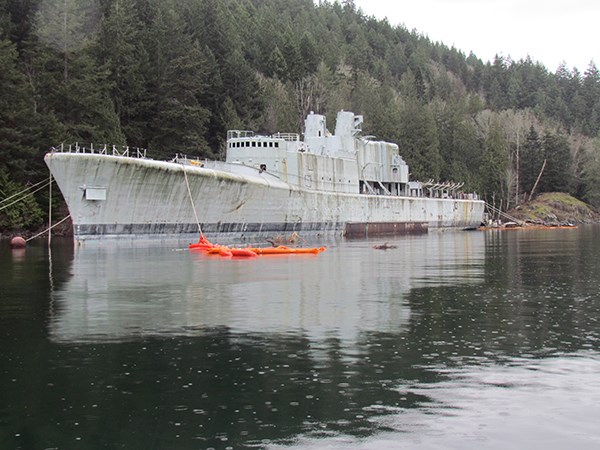The fate of the decommissioned destroyer Annapolis is in front of a federal judge this week.
Environment Canada was scheduled to be in federal court on Feb. 25 and 26 against the Save Halkett Bay Marine Park Society over the right of the Artificial Reef Society of BC (ARSBC) to sink the ship, which is slated to become B.C.’s eighth artificial reef.
The basis of the application to the court by the Halkett Bay group, which was to quash the disposal at sea permit, is that the paint on the ship is dangerous to marine life and therefore Environment Canada should not have issued the permit.
The group had tests done on paint chips from the hull of the 1960s era Annapolis and say dangerous chemicals were found.
Gary MacDonald, with the Save Halkett Bay group said they asked Quebec-based researcher Emilien Pelletier to look into the tributyltins (TBTs) found in the paint.
“After reading in his report that the level of TBTs present in the paint is 33 to 200 times higher than that shown to cause significant impacts on the food chain, we decided that although we still oppose the sinking in Halkett Bay, getting the Annapolis cleaned needs to be our main goal,” MacDonald said.
The group’s lawyer, Martin Peters, said there is general agreement between all the parties that the ship is too unstable to be anything but sunk, due to the holes that were cut in it by the artificial reef society for its scheduled Jan. 17 sinking.
Peters said he has found a contractor that could take the remaining paint off the ship, as it is, and offered on behalf of Save Halkett Bay to withdraw the federal court application, if the ship were cleaned up by the contractor.
Peters said he expected that Environment Canada would agree to the offer, but the organization refused.
“I proposed that we will withdraw, if you clean up the ship, then at least we know the ship going into Halkett Bay is clean, and the answer was no,” said Peters.
According to Peters, the court could say either the disposal at sea permit was issued in a valid way and it will be upheld, or it wasn’t.
The court doesn’t have the power to order more of a clean-up.
If the court’s decision is that the permit wasn’t issued properly, given the condition of the ship, he isn’t sure what would happen next.
More than 1,000 volunteers cleaned the former Annapolis to prepare it to be sunk, according to the reef society.
Environment Canada issued a disposal at sea permit to the ARSBC to sink the Annapolis once all assessment and cleanup requirements were met, including anything that could cause marine pollution had been removed to the maximum extent possible, before sinking, according to an Environment Canada spokesperson.
In July 2014, an Environment Canada approved inspector conducted an independent inspection of the Annapolis, on behalf of ARSBC. According to Environment Canada, the inspector’s report determined the Annapolis met the clean-up standard.
The Environment Canada spokesperson said via email that it would be inappropriate for the organization to comment further while the case is before the court.
Rick Wall of the Artificial Reef Society of B.C., said the feedback the society is receiving from volunteers, former crew members and interested parties continues to be positive. “We hope to move forward, once a decision has been rendered by the federal court.”
Check squamishchief.com for updates to this story.



